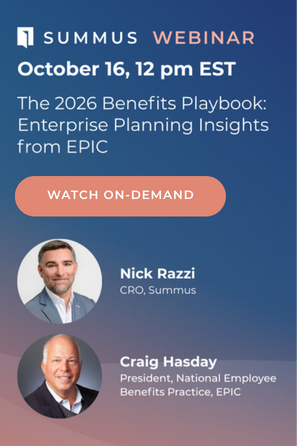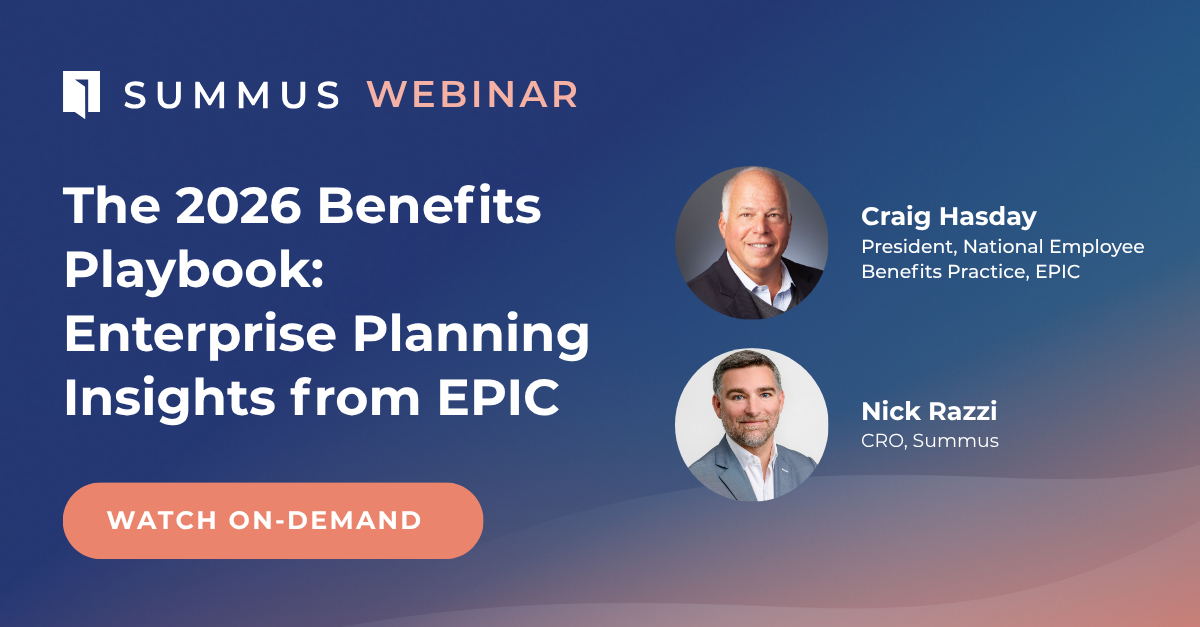By: Julian Flannery, Chief Executive Officer, Summus
At Summus, we believe in the transformative power of informed, forward-looking leadership, especially when confronting entrenched systemic challenges. A recent McKinsey analysis, “Transforming Employer Health Benefits: Large Employers’ Activist Role,” resonates profoundly with this conviction. It signals an era where employers are no longer passive sponsors of health benefits but active architects driving systemic change.
Put simply: Large employers have the power to influence the shift needed to provide a better all-around healthcare experience.
The Stakes: Elevated Costs and a Strategic Imperative
McKinsey identifies the enormity of the issue: large employers, defined as those covering more than 10,000 employees, now account for approximately $800 billion in healthcare expenditures, representing coverage for 165 million lives.
With national healthcare costs projected to rise by 9-10% annually through 2026, the weight of traditional year-over-year tweaks is no longer tenable. In this climate, employers must pivot from passive cost-sharing measures to assertive, investment-grade strategies.
A New Playbook: From Sponsor to Activist
McKinsey outlines the fundamental shift that large employers are taking:
- Reimagining clinical networks to favor high‑value, quality‑oriented providers.
- Confronting specialty drug costs, notably from the GLP‑1 weight-loss class.
- Embracing value‑based, risk-sharing contracts with payers.
- Deploying high-ROI programs that improve care management and outcomes.
- Piloting value‑based insurance designs that align costs with outcomes.
These aren’t incremental shifts. Rather, they represent a departure from orthodox benefit design toward that of ongoing experimentation and results-driven accountability.
The Employer as an Innovation Conduit
What distinguishes large employers is both scale and influence. Because they underpin a vast portion of U.S. care delivery systems, from provider networks to health plan design, they can drive meaningful change. McKinsey asserts that if employers demand partners who offer “opportunities to improve offerings year-round,” the ecosystem will inevitably shift.
To succeed, this partnership model must be anchored in:
- Data transparency and population insights. Employers must wield population‑level and individual claims data to craft bespoke benefit strategies.
- Collaboration on pricing models. Partners must move beyond unit pricing toward shared‑risk frameworks that reward outcomes, not volume.
- Integration of technology and AI. Leveraging real‑time analytics to track performance enables agility and rapid redesign in deployment.
At Summus, we see this as a natural alignment with our mission: translating clinical insights into scalable, system-level innovation.
The Competitive Divide: Innovate, or Be Left Behind
McKinsey issues a stark warning: employers who cling to conventional, commoditized procurement models risk being outpaced by peers who demand deeper value and accountability.
The data reinforces this notion:
- Two‑thirds of large employers are exploring carrier changes within the next four years.
- Two‑thirds also aim for 10%+ cost reductions via innovation.
Such sweeping ambitions require partners who match employer sophistication, bringing clinical depth to costly areas, operational transparency, and an outcome-based mindset.
The Mandate for Employers
To effectively drive real innovation and impact in healthcare, CEOs, CFOs and CHROs need to be directive, including:
- Championing next-gen healthcare strategy by changing the viewpoint of healthcare from being a cost center to an investment strategy.
- Demanding clarity and data fluency from vendors and health plans that align with their investment thesis.
- Authorizing investments in innovative concepts and deeply monitoring their impact.
- Building internal competencies around care outcomes, not just cost control.
Activist leadership in this space is not optional—it’s essential. And, personally, I think this makes for an exciting era in healthcare and benefits design.
Summus in Action
Summus is uniquely positioned to help enterprise employers lead this transformation. Our model is not a point solution, nor a one-off program. It is a platform—built on the strength of physician quality and expertise, powered by data, and designed for enterprise scale.
We bring three critical elements that employers need today:
- Clinical depth. Every journey at Summus is physician-led, ensuring employees and their families get the right expertise, at the right time. Better access and expertise drive better decisions and outcomes.
- Strategic alignment. We integrate with employer goals, whether that is guiding employees to higher-value care settings or navigating complex conditions with precision and align our solution with outcomes.
- Enterprise rigor. Our technology provides the transparency, analytics, and accountability required to prove outcomes and deliver sustained value.
In practice, this means our clients are already innovating. They use Summus to guide employees through complex care decisions, redesigning referral patterns toward higher-quality providers, and creating measurable impact on costs while elevating employee experience.
As more CEOs and CHROs embrace this new mandate, Summus is excited to play a role in redefining how employers drive a better healthcare system.
Final Word
McKinsey’s “activist employer” paradigm marks a critical inflection point. It reframes healthcare leadership from a cost center to be managed into a strategic lever for enterprise success.
To the CEOs, CHROs, and benefits leaders, I believe the time is now.
At Summus, we are committed to partnering with enterprise leaders who agree with the strategic value of bold and innovative investment. Together, we can reframe healthcare not as an expense line, but as a strategic investment in talent, culture, and long-term enterprise value.
The next decade will define leadership excellence in healthcare. Let’s make it meaningful.
Take the first step. Explore how Summus can help your organization solve the most common challenges impacting employers.





